
Cadette Workbook for
Earning Your Silver Award

Cadette Workbook for Earning Your Silver Award | 2
Celebrate! Check with your council to see if
they host a local ceremony or celebration, or
organize one of your own!
Silver Award at a Glance
Identify issues that you’re passionate
about and how they affect your community.
Build your team. Work with a team of up to
three other Cadettes or on your own. Either
way, plan to partner with the community.
Explore your community to learn more
about issues that interest you. This can be your
neighborhood, your school, Girl Scouts, your
place of worship, or another community of
interest.
Choose your Silver Award project
based on your passions and what you’ve
learned by exploring your community and
talking to others.
Step 5:
Step 6:
Spread the word and submit your
nal report. Inspire others! You can give a
presentation to another Girl Scout troop, your
local Girl Scout community, or to students at
school. Turn in your nal report to your council
before September 30 after completing 8th grade.
Prerequisite:
Go on a Cadette Journey, including
the Journey’s Take Action™ project.
Step 1: Step 2:
Make a plan and submit your
Project Proposal to carry out your Silver
Award Take Action project.
Step 4: Step 3:
Put your plan in motion. You and your team
will each spend about 50 hours to earn the
award. Planning time counts too! Use the
Time Log to track your time.
Step 7: Then...
7 Steps to the Silver Award

Cadette Workbook for Earning Your Silver Award | 3
Silver Award at a Glance ............................................................................................................................. 2
How to Use This Workbook .................................................................……................................................ 4
Key Elements of the Silver Award Project ................................…........................................................ 5
Take Action vs Community Service ............................................….......................................... 5
Project Requirements .................................…............................................................................................. 6
Prerequisites ..............................................................................………......................................................... 7
Step 1: Identify issues ..................................................................………..................................................... 8
Step 2: Build your team ………………................…………….............................…..............................….……… 10
Step 3: Explore your community …….......................……………………….….....…......…………...................… 12
Step 4: Choose your Silver Award project ……………....................................………........…………………. 14
Step 5: Make a plan and submit your Project Proposal …………………......................……......……… 16
Step 6: Put your plan in motion …………………………….……………………………......……….......……...……….. 20
Step 7: Spread the word and submit your Final Report ……….……..………......……......………………. 22
Now it’s your turn - template pages …………………...……….........……......……………………………………….. 24
Girl Scout Silver Award™
Checklist …………..…...………......………......………….………….……… 24
Silver Award Take Action Project Sample ……………………………......……………………………… 26
Take Action Project Decision Bracket ……………………………......……….......…..…….…………… 27
Mind Mapping Diagram …………….……………………………......……….....…..……………….…………… 29
Pros/Cons Diagram ……………………………………………………......……….………..………………………… 30
Budget Worksheet ……………………………………………………......……..….......……………………………… 31
To-Do List …………………………………………………………………......……..........…….…..…………………… 32
Time Log ……………………………………………………………….......……………………….……………………….. 33
Table of Contents

Cadette Workbook for Earning Your Silver Award | 4
How to Use This Workbook
This workbook is designed to lead you through
the 7 Steps to the Silver Award. Use the sample
Silver Award Take Action project in the template
pages to follow all the examples provided
throughout this workbook.
If you need more detailed explanations, review available resources with your leader or adult
volunteer. The Adult Guide for Earning the Silver Award goes into more detail; the Volunteer
Toolkit has Silver Award meeting plans; the Girl Scout Activity Zone has helpful videos and
self-guided activities to help you explore the key requirements of the Silver Award; the Silver
Award webpage and gsLearn have on-demand Silver Award training.
What do Silver Award
Girl Scouts say?
“Do what you love
while helping others!”
“Denitely do it. We
learned a lot!”
“Be realistic.”
“We enjoyed
giving back to our
community!”
“Plan, and plan more.”
“Time management is
the hardest.”
“Just start! Don’t put
it off because you’re
looking for the perfect
project.”
“Ask for help!”
You’re a registered Girl Scout Cadette
(in grades 6–8).
You’ve earned a Cadette Journey, including the
Journey’s Take Action project.
You will be able to nish your project and
submit paperwork by September 30 after 8th
grade is completed.
You’re excited to plan a Take Action project
with the required elements by: practicing
leadership, addressing a real root cause of a
community issue you care about, and creating
a plan to make your project sustainable.
Excited to earn your Silver Award?
Check these off rst.
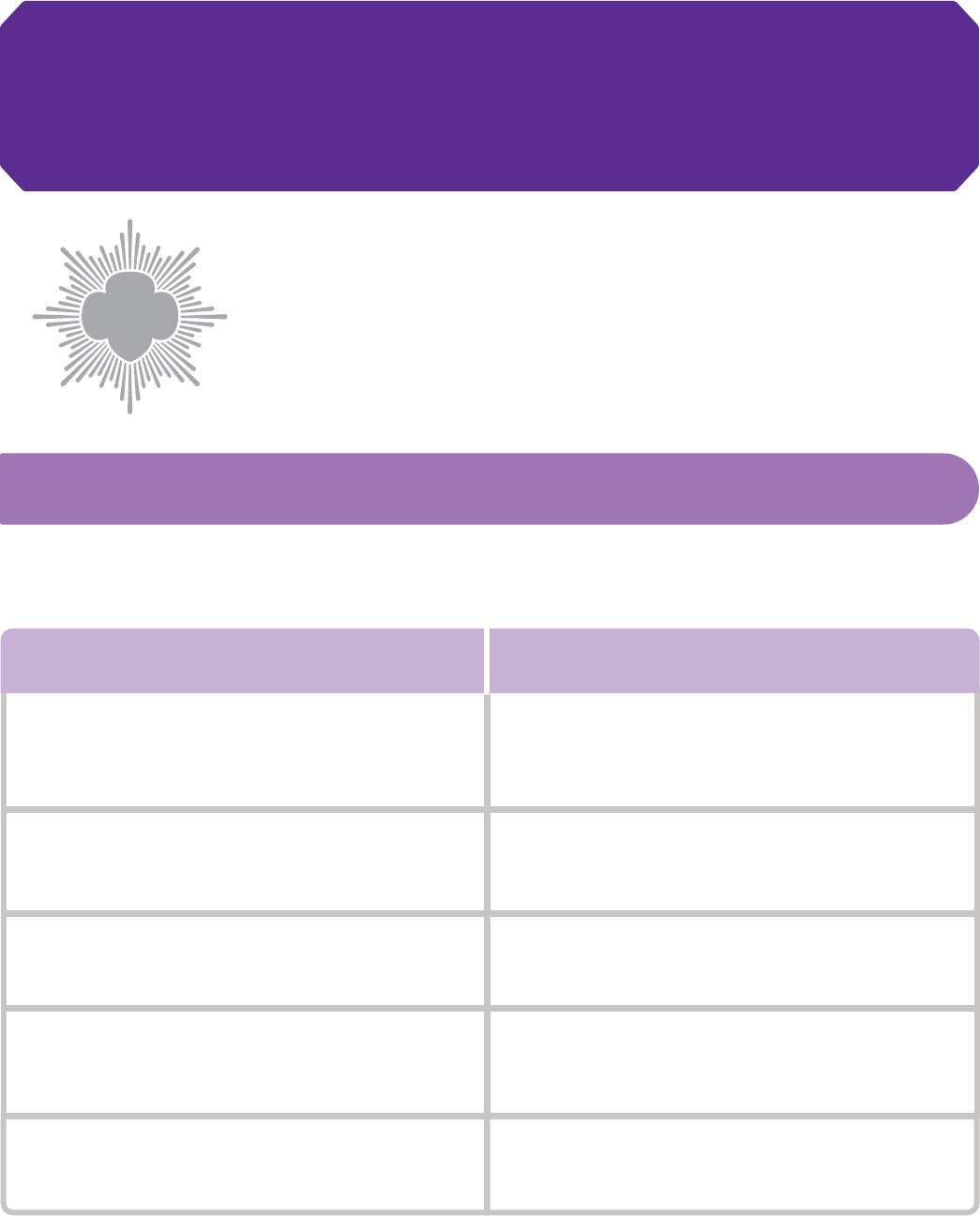
Cadette Workbook for Earning Your Silver Award | 5
The Silver Award Take Action project may be
different than other projects you’ve done as a
Girl Scout.
If you earned a Bronze Award, some of the steps will be familiar. If you didn’t earn a Bronze Award—
that’s OK! Any Girl Scout Cadette can rock a Silver Award Take Action project.
Take Action vs. Community Service
Take Action
A long-term project with sustainable and ongoing
inuence that addresses an issue’s root cause
Creating a unique initiative to address
an issue’s root cause
Creating and leading your own team
of volunteers
Setting the goals and leading a team to achieve them
Done WITH the community
Community Service
A short-term effort that helps something or
someone fulll an immediate need
Done FOR the community
Joining an existing effort to solve an issue
Joining an existing team, usually as a volunteer
Working toward a goal that’s set by others
Before you begin, it’s helpful to understand the difference between a
Take Action project and a Community Service project. Here’s the difference:
Key Elements of the
Silver Award Project
Often, a community service project idea can be developed into a Take Action project. For example, you may want to collect items for a crowded pet
shelter. That’s a service project, of course. But if you partner with the shelter to understand the root causes of overcrowded shelters and come up
with a solution, like workshops to educate others about spaying and neutering pets, that’s a Take Action project.

Cadette Workbook for Earning Your Silver Award | 6
Project Requirements
Take Action projects have up to ve elements:
the Girl Scout Gold Award requires all ve; the
Girl Scout Silver Award requires three; and the
Girl Scout Bronze Award requires two.
To earn the Silver Award, you need to:
• Show leadership.
• Research and address a root cause of an issue in your community.
• Create a plan to make the project sustainable.
• Optional: “Try” to make your project measurable.
• Optional: “Try” to make a national and/or global link.
These are the key elements. If they are new to you—no worries! We’ll
identify how to fulll each of these requirements in this workbook. You’ll be
a Silver Award Take Action project expert in no time.
Leadership Root Cause Sustainable Measurable
National
and/or
Global Link
Bronze
Juniors
Silver
Cadettes
Gold
Seniors/Ambassadors
Required element Introduction of new concept
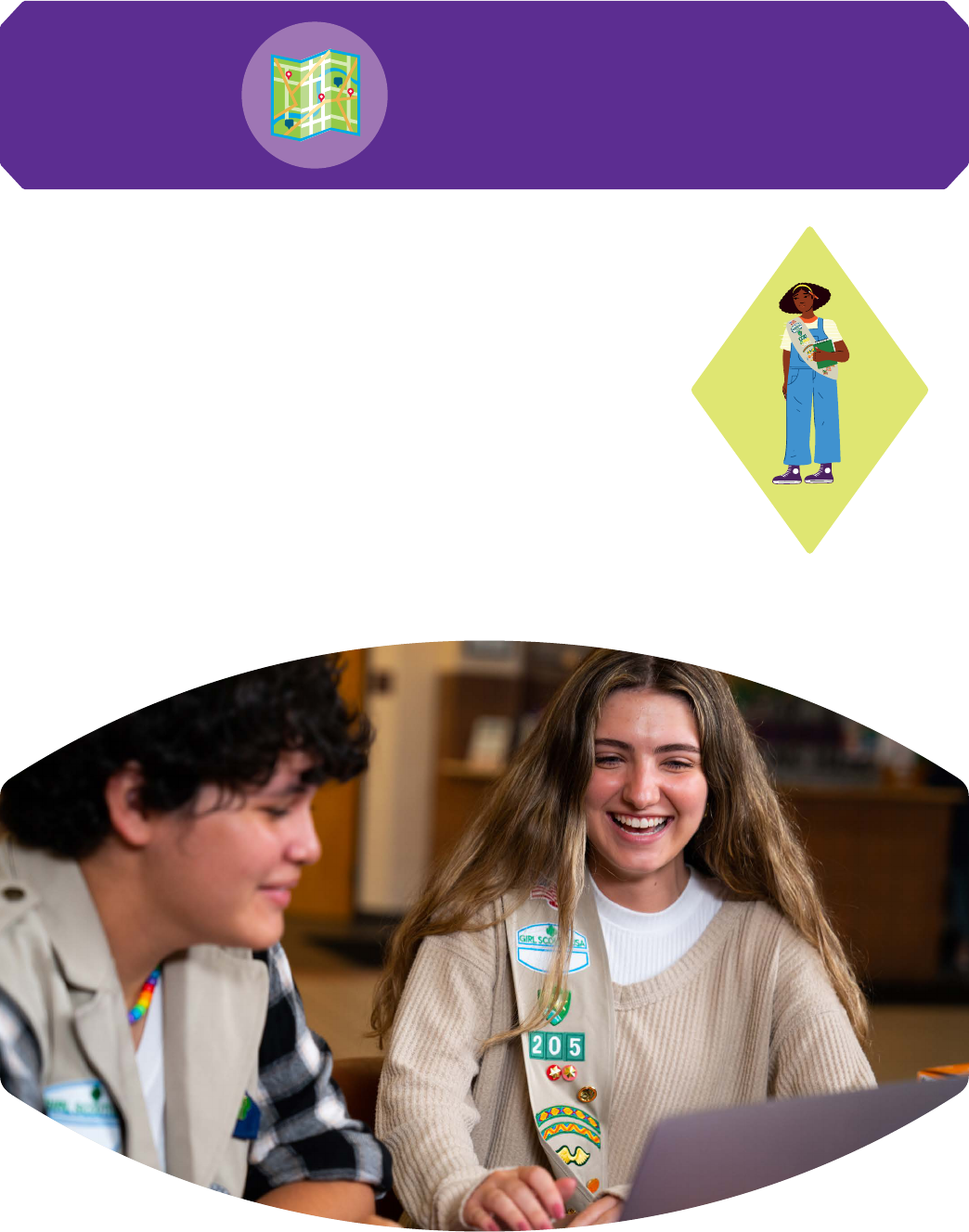
Cadette Workbook for Earning Your Silver Award | 7
Prerequisites
Before getting started, make sure you have
completed a Cadette Journey, including the
Journey’s Take Action project.
In your Silver Award Project Proposal, you will be asked to provide the name of the Cadette
Journey completed and the completion date.
In addition, you will be asked to reect on these questions:
• What did you do?
• What did you learn?
• What will you do better, or differently, next time?
This reection will help you have a successful Silver Award project.
MY
PROMISE
MY
FAITH
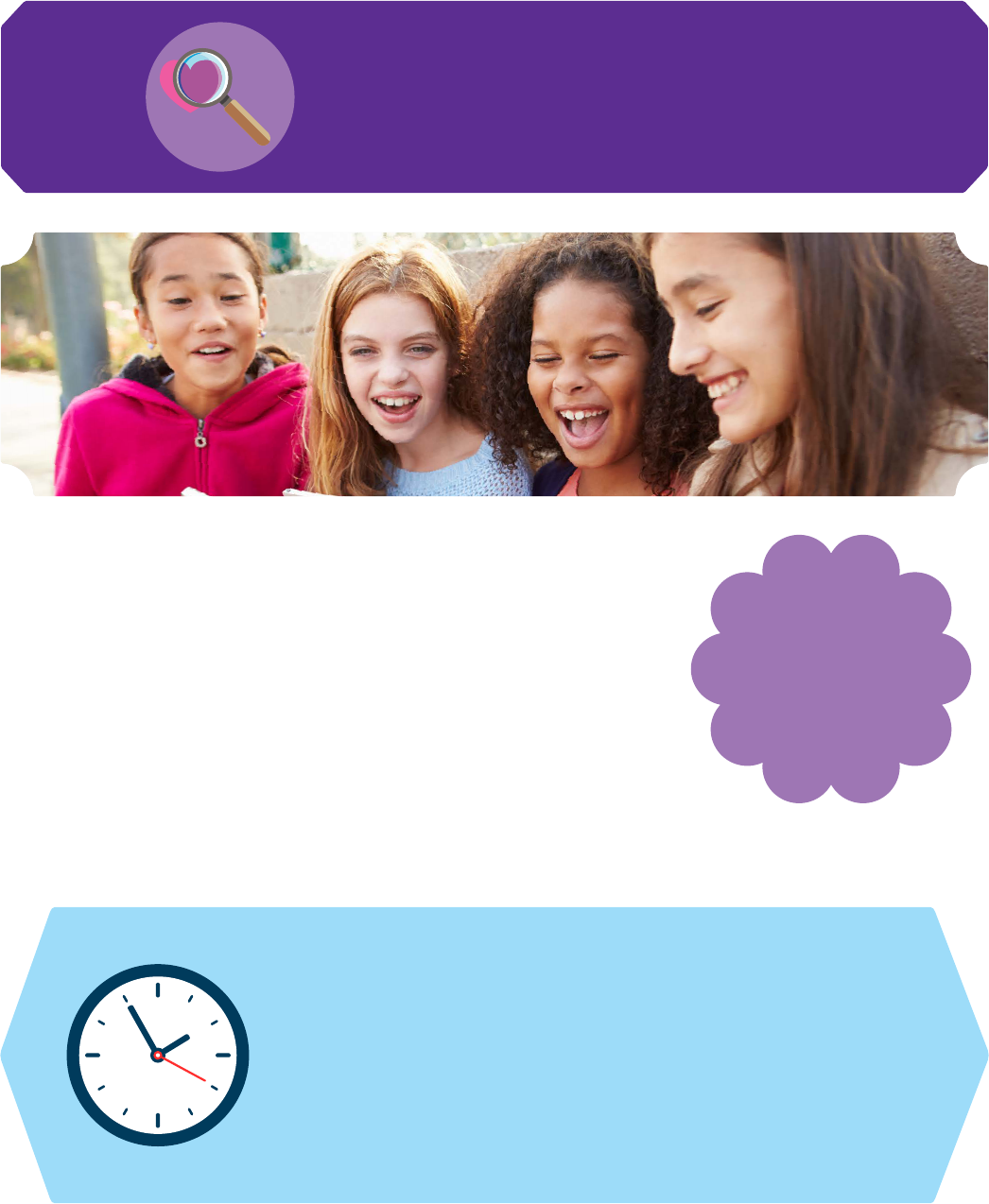
Cadette Workbook for Earning Your Silver Award | 8
How to start? Begin with your passions! What
makes you excited? What do you love to do?
What have you always longed to know more
about?
Then, look to your community. What are the challenges? Who could use some help? Is there a
way to bring your passions to the community to make the world a better place?
There are no wrong answers—no pressure. In this step, you’re simply exploring, jotting down
what comes to mind.
Check out the sample Silver Award Take Action project in the template pages to follow
all the examples provided throughout this workbook.
Step 1: Identify issues.
Use the chart on the
next page to help you
nd the issues that
interest you.
Tip: Once you begin this step, start tracking your time so you
don’t get stuck trying to recreate it at the end. Each Cadette
should spend approximately 50 hours working toward the
Silver Award. Track your time using the Time Log found in
the template section, a spreadsheet, or a piece of paper—just
don’t lose it.

Cadette Workbook for Earning Your Silver Award | 9Step 1: Identify issues.
Environment
Education
Trees are essential for so many animals.
I see a lot of trees being cut down to
make room for new buildings.
I want to be a teacher and I enjoy
working with kids.
There is less space for the birds and
their nests.
All children should be able to learn and
have fun while doing it. More tools are
needed to assist teachers in keeping
learning fun.
What issues are you
passionate about?
How do the issues affect
your community?
Why are these issues
important to you?
Match your talents and skills with the issues you identied and the people you want to help using the Take Action Brainstorming Decision Bracket,
which can be found in the template pages.
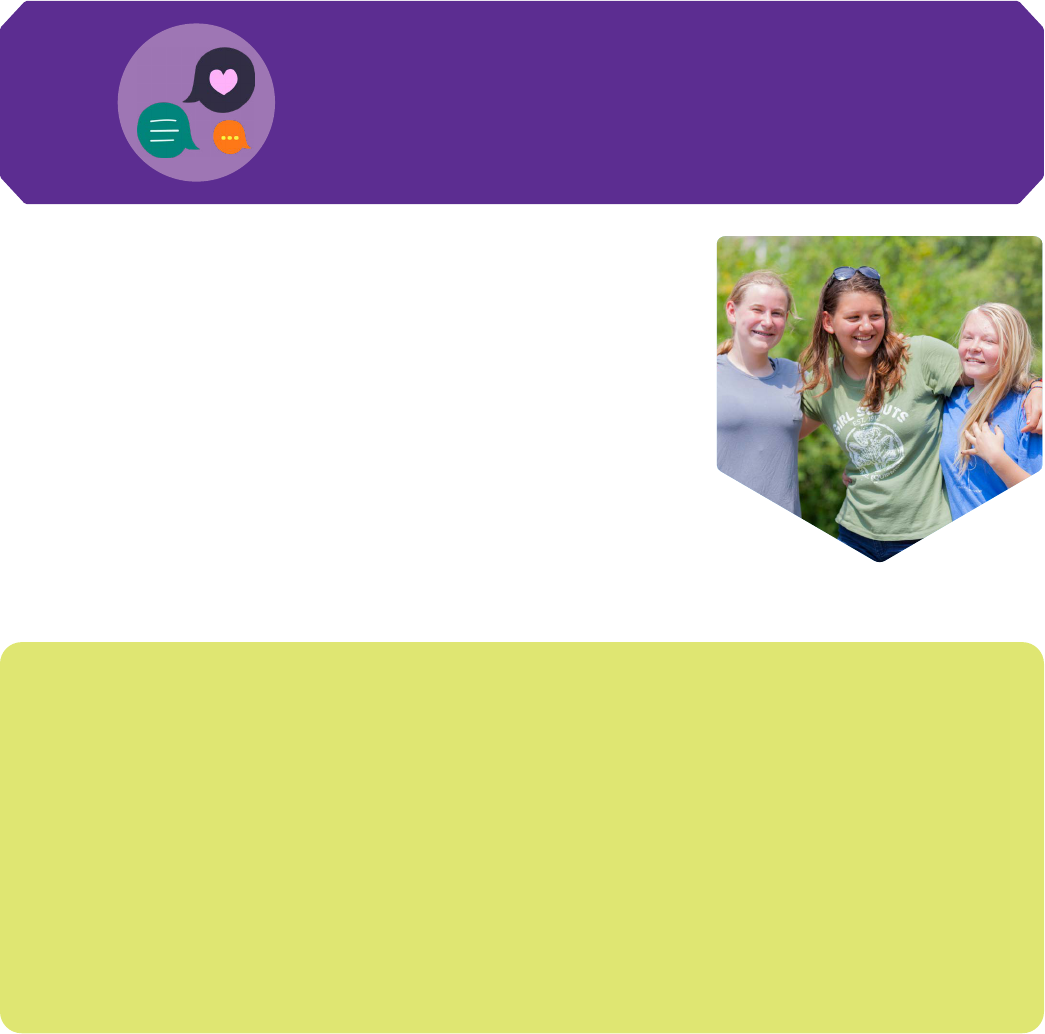
Cadette Workbook for Earning Your Silver Award | 10
Step 2: Build your team.
To meet the Silver Award Leadership
requirement, you’ll need to build a team.
You’ve got options:
• Small team model: Work with a team of up to three other Cadettes. Your team can be
made up of Girl Scouts from the same troop, other troops, or individually registered Girl
Scouts. Each Girl Scout must play an active role in choosing, planning, developing, and
completing the team’s project, and must have their own role and responsibilities in the
project.
• Solo model: You can create and implement a project on your own. Recruiting and engaging
your peers and/or adult volunteers from your network and around your community will be
necessary to complete specic tasks.
Since each Cadette will spend 50 hours on this project, focus on an issue you are really
interested in. Don’t just pick an issue your friend is doing because you want to work
with them.
• Respect your teammates and their different points of view.
• Decide on team rules—use the Girl Scout Law as your guide.
• Contribute your share.
• Have a conict? Resolve it quickly by talking things out.
Teamwork makes the dream work.

Cadette Workbook for Earning Your Silver Award | 11Step 2: Build your team.
If you’ve chosen a group for your team, hold your rst meeting.
Explore how you can collaborate. Play a game or two to get the ball rolling—you might try “spider web!” First, form a circle. Then, toss a ball of yarn
or string to each other. The person receiving the yarn tells the group a characteristic about themselves before tossing the yarn to the next person.
The yarn should be held tightly and above the ground at all times. Use this activity to discuss how the members all depend on each other. If a single
person pulls the yarn, it affects everyone in the group; if one person’s yarn is cut, the whole web is broken. Have fun!
For more team-building activities, ask your adult volunteer, advisor, or another trusted adult to check out the Volunteer Toolkit Silver Award
Meeting Plans.
No matter which option you choose:
• Plan to partner with community members to learn about your issue, discover the root
cause(s), make a plan, and take action. Community members might be teachers or school
administrators, neighbors, business owners, religious group leaders, or staff at a local
community center working on the issue you are interested in. They should be experts in the
issue you’re working on.
• Show active leadership by involving others in your efforts and directing them to help you meet
the goals of your project. Keep track of who helps you and how so you can thank them upon
completion and list them in your Final Report.
• You should have the support of at least one registered, background-checked adult Girl
Scout volunteer who is responsible for safety and Silver Award procedures.
• Try it: Having a project advisor is not required but can be very helpful. Lots of people are
happy to play a part in helping a Girl Scout make the world a better place.
• The Final Report will ask you to identify and reect on your individual leadership role,
responsibilities, and experience.
A project advisor is an adult who is an expert that has some level of knowledge,
skills, or access to resources that can help with your project.
While parents/legal guardians and troop leaders can be project advisors, try to
expand outside your familiar circles and grow your network!
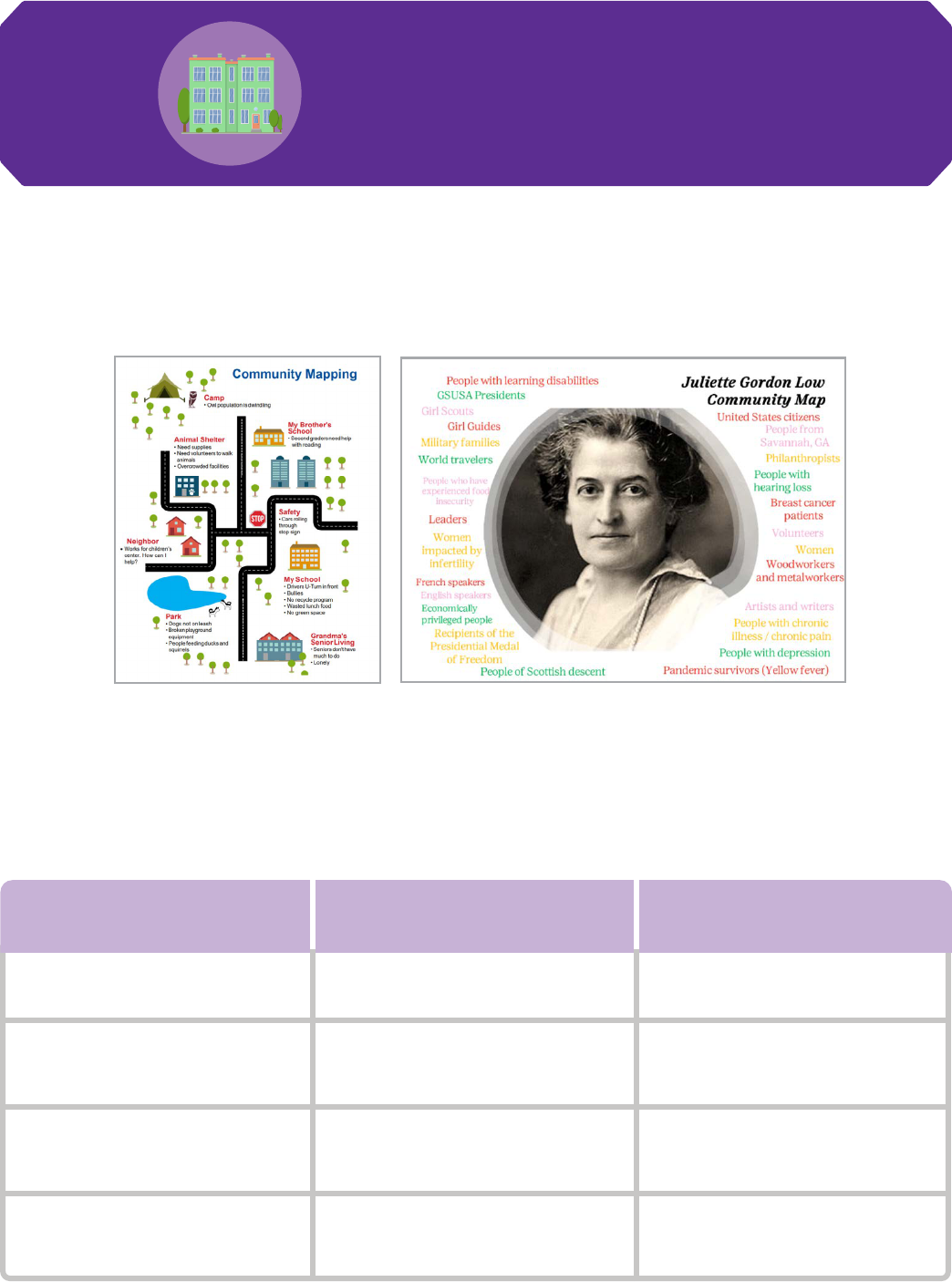
Cadette Workbook for Earning Your Silver Award | 12
Step 3: Explore your
community.
1. Draw a community map to keep track of what you see and your
ideas for change.
2. List the names and contact info of those you meet in your
community who might be able to help you with your project.
Teacher, neighbor
Carpenter, local store owner
Neighborhood preschool
Local hardware store
Ideas on how to engage preschool
students in learning
Ideas for the materials to use for the
hands-on shoe-tying tool
Name and Contact Info How might they help?Organization
As you explore, remember that a community can be a physical place on a map or a group of people.
Community experts are important because they can offer their knowledge or advise you on how to take action on the issue(s) you are thinking
about addressing through your project.

Cadette Workbook for Earning Your Silver Award | 13Step 3: Explore your community.
3. Learn what others know of your issue.
4. Research root causes by asking what causes an issue and why, then
ask why this happens again.
Step 2:
Ask: What activates
the issue?
Step 3:
To nd a root cause, ask:
Why does this happen?
Step 1:
Write your community
issue in the largest circle.
Teachers
School nurse
Parents
School nurse teaching
students
Learning the skills
at home
Shoelaces untiedStudents tripping
Students forgot how
to tie shoes after the
presentation because
there was no practice
involved
Can’t always wear
shoes without laces
Presentation on
how to tie shoes
Shoes without laces
Students not getting
enough practice
Busy schedules
Students needing more
support to learn how to
properly tie their shoes
No time to teach
shoe tying
Who I
Talked to
Issue(s) They
Suggested
What Causes
the Issue
What Worked
in the Past
What Didn’t
Work
Community Issue:
Preschoolers keep tripping on the
playground.
Root Cause:
Preschoolers aren’t
learning how to tie
their shoes.
Root Cause:
The pavement
is uneven.
Activator:
Their shoes are untied.
or
Chat with the people you know to learn about your issue in the community. It’s another way of nding a project idea that might interest you.
Understanding the root causes of your issue is an important part of a Take Action project. By looking at the root causes of an issue, you gure
out why the issue is happening in the rst place and then you can create a solution to stop it from happening again.
Uncovering root causes may seem hard but it can be surprisingly easy. Brainstorm with your team, use colorful sticky notes to track your ideas,
or create your own mind map diagram like the one shown here. Keep asking “Why?” and you may nd that there is more than one root cause!
Use the blank mind mapping diagram in the template pages to nd the root cause of your project’s issue.

Cadette Workbook for Earning Your Silver Award | 14
Step 4: Choose your
Silver Award project.
You’ve thought about your interests and
passions. You’ve explored your community.
You’ve talked to others, and you’ve researched
to understand root causes of one or more
issues. The moment you’ve been waiting for has
arrived: it’s time to choose a project!
Make it ofcial by writing it down:
The issue my project will address is…
I care about education and I like working with children. I learned that lots of preschoolers are tripping on the school playground because they are
not properly tying their shoes. The school nurse has seen an increase of injuries and is concerned someone will hurt themselves badly.
It matters because…
Injuries at school take away from children’s fun and learning time. It’s important that all children are safe and able to play. Mastering a task like
shoe tying will help preschoolers be more independent and condent.
My target audience (who is going to benet) is…
Preschoolers and school staff.

Cadette Workbook for Earning Your Silver Award | 15Step 4: Choose your Silver Award project.
Review the info you’ve collected. Check out your issues chart, your community map, and the ideas you gathered from
talking to others. If you’re working with a team, sort the information you’ve gathered together and rank your ideas.
What matters to you most? Or, where could you or your team make the most positive change? Make a list of pros and
cons you are considering. Use the Pros and Cons Chart in the template pages.
Feeling overwhelmed? Some issues are complicated and have a lot of pieces. It might help to narrow your focus. Can
you break the issue down and take action on one part? Contact your local council if you need help.
Still not sure about your project? Try these to help you make a decision:
A root cause of my issue is…
Preschoolers are not learning how to tie their shoes. Maybe they are being taught, but they aren’t remembering it. It is clear they need more practice
in learning to tie their shoes.
My team’s project idea plans to address the root cause by…
Developing a workshop to teach preschoolers to tie their shoes, with a hands-on tool to help them practice. The hands-on tool will stay at the school
so the students can practice whenever they want.

Cadette Workbook for Earning Your Silver Award | 16
By now, you have chosen a Silver Award Take
Action project and are ready to make a plan to
get it done.
Planning ahead helps your Silver Award Take Action project go smoothly. Answer the
questions below, then review the Silver Award checklist in the template pages at the end of this
workbook to decide if your plan is complete or if more planning is needed.
Step 5: Make a plan
and submit your
Project Proposal.
Your plan is just
that: a plan. If it
changes over time,
that’s OK!
How will your unique talents and
leadership skills be used in this
project?
Gloria loves to build things, so she will
lead the details of the hands-on tool.
Ava likes research, so she will lead
the gathering of information on ne
motor and developmental skills for
preschoolers for the workshop materials.
Zuri prefers organizing and public
speaking, so she will lead the scheduling
and operational details for the actual
workshop events.
Question Your AnswerExample

Cadette Workbook for Earning Your Silver Award | 17Step 5: Make a plan and submit your Project Proposal.
How will you create a plan to make
your project sustainable?* Three
possibilities are:
1. Create a permanent solution that can
be used after the project is complete.
2. Educate and inspire others in the
community or within Girl Scouts to be
part of the change.
3. Advocate to change a rule, regulation,
or law and encourage others to join.
Proposed Start Date
Proposed End Date
Is the time frame realistic? (Y/N)
The team chooses Option 2: They will
present workshops to students at the
preschool and provide the workshop
outline and permanent tool to the school
who will continue to teach shoe tying.
Fall of 7th Grade
Fall of 8th Grade
Yes
Question Your AnswerExample
* Your project is sustainable if the impact lasts, even after the project is over. Putting a plan into place to sustain your project is required; however,
how the project is actually sustained is often outside Girl Scouts’ inuence or control. See The Adult Guidefor Earning the Silver Award for specic
examples.
What community experts will you
work with?
Gloria will meet with a teacher and the
owner of the local hardware store.
Ava will meet with preschooler parents
and teachers.
Zuri will meet with the preschool
administrators.

Cadette Workbook for Earning Your Silver Award | 18
Silver Award projects sometimes require
money or nonmonetary donations of goods.
If you think your project will require this, then
please estimate supplies/donations needed and
potential costs.
Estimate How Much
They Will Cost
Estimate How Much
They Will Cost
Supplies Needed Supplies Needed
Pressed wood
Nails
Copies of workshop outline
Yarn
$25
$10
$8
$5
Example Budget Worksheet: Estimated Budget Worksheet:
Step 5: Make a plan and submit your Project Proposal.
Take Action projects often focus on education and advocacy. These generally don’t cost very much. If your Silver Award Take Action project
has a budget that seems unrealistic, re-evaluate. Is the project truly a Take Action project?
For the Silver Award Final Report, use the Budget Worksheet in the template pages to list the items you received (including troop funds, money
earned, donations, etc.), the cost of supplies purchased, and to identify who and where they are from.
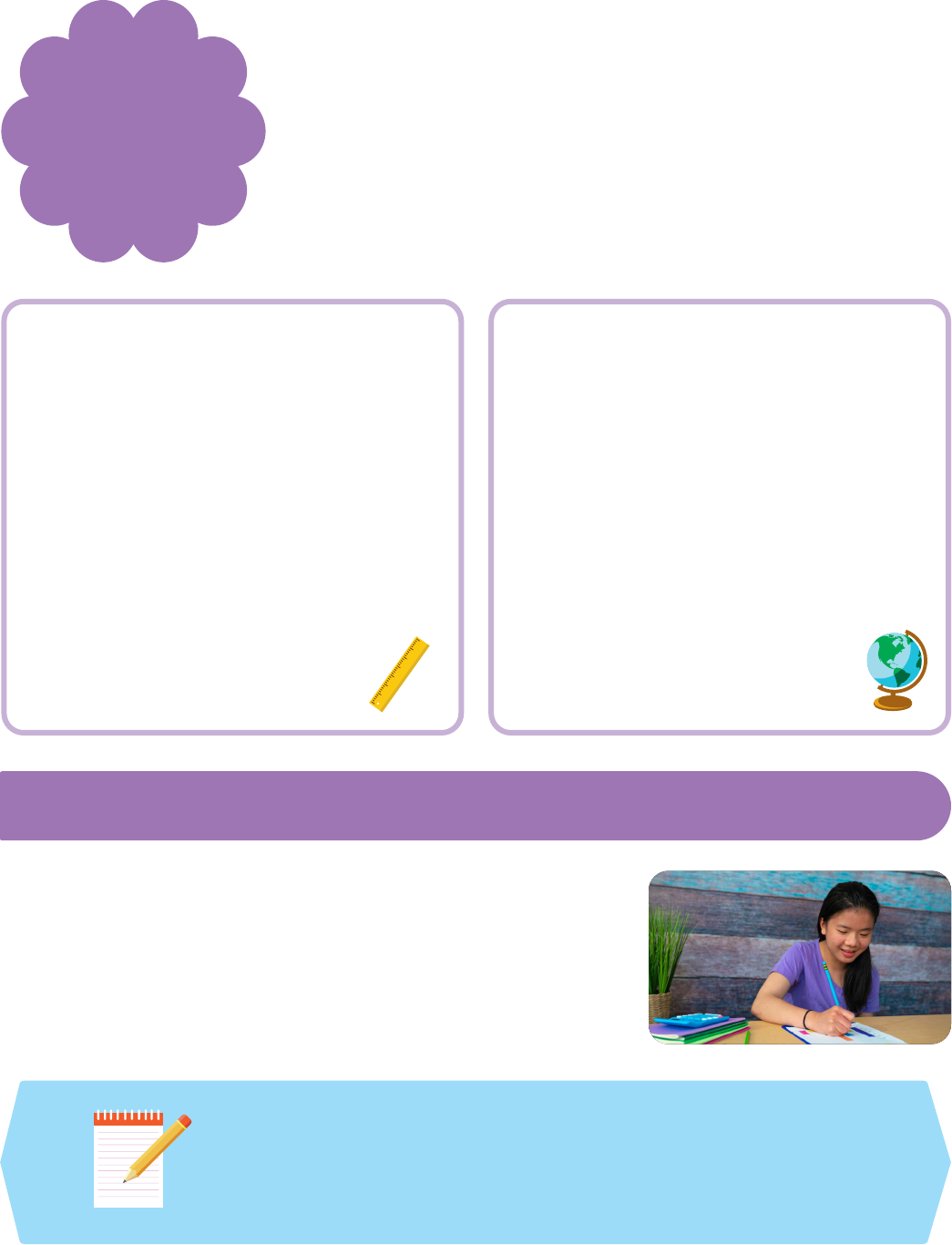
Cadette Workbook for Earning Your Silver Award | 19
Making your project measurable and
making a national and/or global link is
optional. Why take these steps? They will make
your project stronger and help you prepare for
the Girl Scout Gold Award.
Can you make your project
measurable?
As you work on your project, try to set one goal that will
help you measure your project’s success. Think about what
you can count to show the impact you've made on your
community issue.
Possibilities include:
• the number of people the project helped.
• the number of people who got involved.
• a number that shows the change in a community's need
(survey before and after).
Write down your goal in your Project Proposal.
Can you make a national and/or
global link?
Your project has a national and/or global link when you can
identify how other people and places address your issue.
You can:
• Investigate how people in other communities or other
parts of the world address your issue.
• Ask: What kinds of programs do they have in place? How
can you learn from these? Can you incorporate what you
learn about other communities into your project?
Share what you learn in your Project Proposal.
Try it!
When you’re ready, make it official:
Paste your answers into the Silver Award Project Proposal and submit to your troop
leader and/or council for review—they’ll make sure you are on the right track!
Submit your Silver Award Project Proposal.
Tip: The Silver Project Proposal must be submitted and approved
BEFORE continuing work on your project. If you are working in a
group, ll it out together!
Step 5: Make a plan and submit your Project Proposal.

Cadette Workbook for Earning Your Silver Award | 20
Step 6: Put your
plan in motion.
Ready to take action? It’s time to put your plan
in motion.
Make a list of things you need to do as shown in the chart below. If you’re working in a team,
decide what tasks each member will do. Then, decide when each item on the list needs
to be completed.
Silver Award Take Action Project: To-Do List
Example
Task
How?
Supplies needed?
Date task needs
to be completed
Gloria
Ava
Zuri
Ava and Gloria;
Zuri review/edit
Ava, Gloria, Zuri
Develop the hands-on tool.
Get supplies for the
hands-on tool.
Discuss ideas with the carpenter
and preschool teacher.
Donation from the hardware
store: pressed wood, nails,
and yarn.
April 8
March 7
Learn about ne motor skills
and developmental stages of
preschoolers.
Find fun ways to teach
preschoolers to tie their
shoes.
Talk with a preschool teacher
or other professional who works
with preschoolers.
Review and sign the online
internet safety pledge with
my troop leader, then research
online.
March 1
March 21
Schedule shoe-tying workshops.
Promote the workshops to
preschooler families.
Create a step-by-step guide for
using the tool to leave with the
school.
Host the workshop.
Discuss possible dates with
preschool administrators,
then check with the team for
their availability.
Create yers advertising
the workshops.
Create on a computer and print
out several copies.
Bring the tool and guide.
March 4
April 2
May 10
May 20
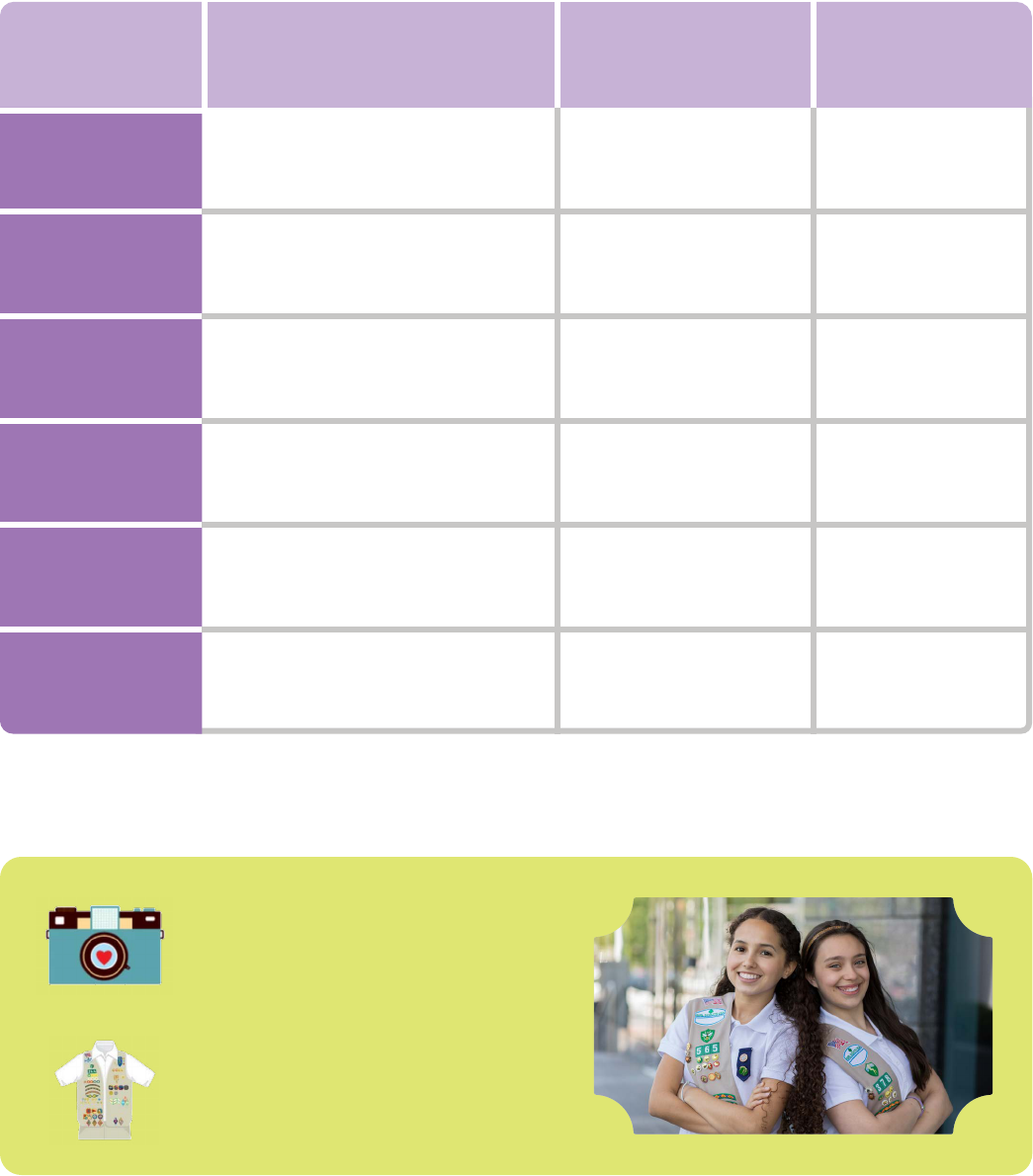
Cadette Workbook for Earning Your Silver Award | 21
You’ve seen Gloria’s example above. Use the blank To-Do List and blank Time Log in the template pages to track your own work.
You and each of your team members must keep track of your own time
spent on the project. See the start of Gloria’s Time Log in the example below:
Date Task Time Spent Running Total
3/7
4/8
4/20
5/1
5/10
6/1
Meet with the carpenter.
Get supplies.
1 hour
1 hour 2 hours
1 hour
Build sample hands-on tool.
Practice how to instruct.
4 hours
2 hours
6 hours
8 hours
Test with the preschool teacher.
Build more hands-on tools to leave with the
school after the workshop.
2 hours
8 hours
10 hours
18 hours
As you work on your project, take photos or
videos to document the work you do. You can
use these in Step 7: Spread the Word and share them
in your Silver Award Final Report.
Step 6: Put your plan in motion.
Be sure to wear your Girl Scout uniform, if you
have one, when taking action in your community;
people may be more eager to help you when they
know that you are a Girl Scout!

Cadette Workbook for Earning Your Silver Award | 22
Step 7: Spread the
word and submit
your Final Report.
Spread the word by sharing the story of
your project.
Why? Because when you share your project, you inspire others—and you bring attention to the
important issue you were addressing. Telling your story is one of the best ways to celebrate all
that you have accomplished!
There are lots of possibilities. You can give a presentation to another Girl Scout troop, your
local Girl Scout community, or to students at school. Create a visual display for a local library
or community center. Submit an article to the local news or your school website. How will you
spread the word?
Turn in your Final Report!
Describe in detail what you did for your
leadership role.
In completing this project, what did you
discover about yourself?
What skills did you gain, and how will these
skills help you in the future?
What part of your project would you change
if you could start over, and why?
Congratulations! You’ve completed
your Silver Award Take Action project.
Get started on your Final Report by
reecting on your experience.
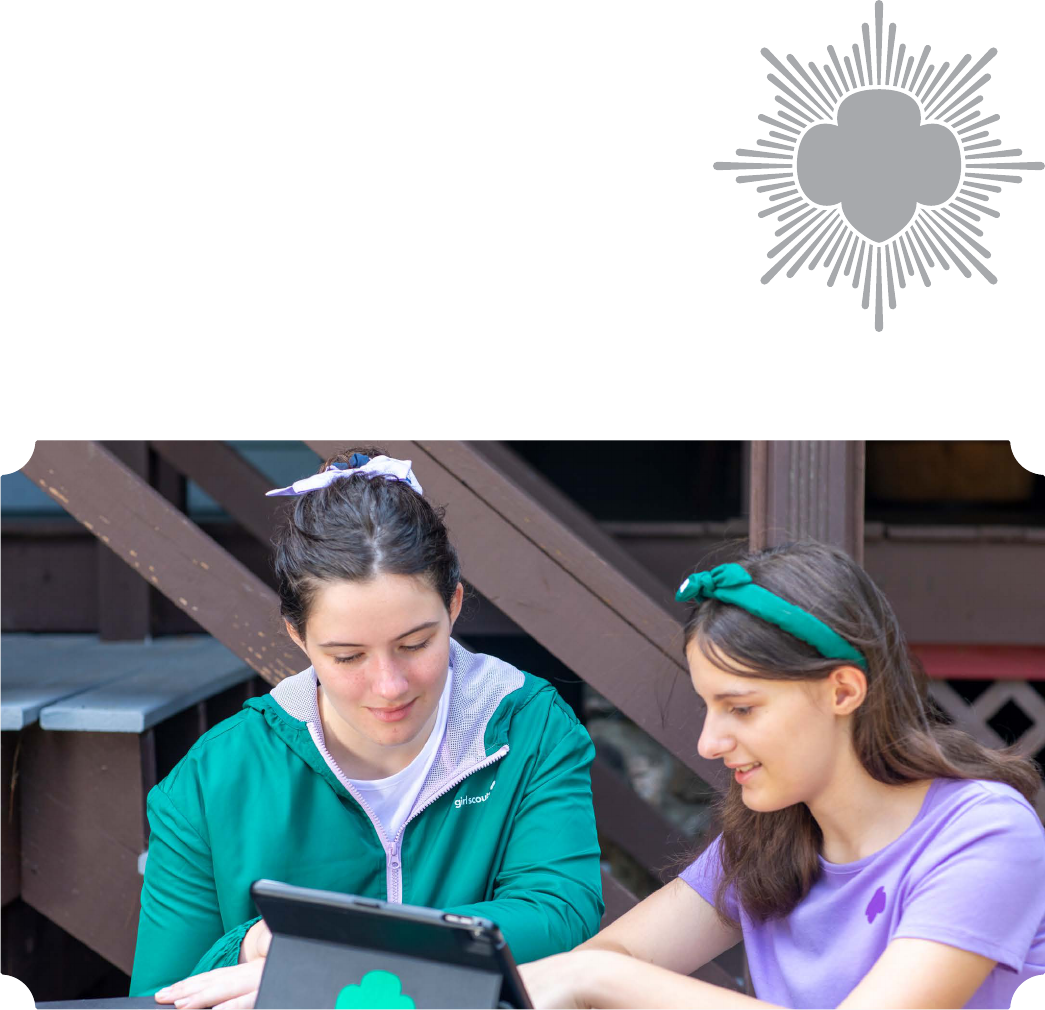
Cadette Workbook for Earning Your Silver Award | 23Step 7: Spread the word and turn in your Final Report.
A special thank you to Girl Scouts San Diego for creating the guide that inspired this national template, to Girl Scouts of Chesapeake Bay for their
denition of active leadership, to Girl Scout River Valleys inspiration on our “what Silver Award Girl Scouts say” and especially to the 2022 Silver Award
Working Group for informing the updated Silver Award Guidelines for our Movement at every step:
Girl Scouts of Connecticut, Girl Scouts of Kansas Heartland, Girl Scouts of Nassau County, Girl Scouts -
North Carolina Coastal Pines, Girl Scouts
Northeast Kansas and Northwest Missouri, Girl Scouts of Northern California, Girl Scouts of San Gorgonio, Girl Scouts of Southern Appalachians, Girl
Scouts of Western Pennsylvania, and Girl Scouts of Western Washington.
Each project team will submit a Final Report
about your project to your leader and council.
The report will contain individual sections for you to share your role and reect. Once your Final
Report is approved, it’s ofcial: You’re a Silver Award Girl Scout!
Keep a copy of your nal report for your own records and submit before September 30 after
completing 8th grade.
What if you didn’t meet all of your goals?
The Silver Award is a leadership award. The most important outcomes are the ones you gain for
yourself: improved condence, better organization, stronger teamwork, and more. It’s less about
the perfect nal product and more about what you discover along the way!
© 2023 Girl Scouts of the USA. All rights reserved.

Cadette Workbook for Earning Your Silver Award | 24
Girl Scout Silver Award Checklist
Check items off your list once you have completed them. When you’ve checked off all the items from each section and received approval from your
troop leader or council, you’re ready for the next section!
Now, it’s your turn!
Use the following template
pages to plan your project.
Prerequisite
I am a registered Girl Scout Cadette (in grades 6–8).
I have nished a Cadette Journey, including the Journey’s Take Action project.
I know that I need to nish my project and submit paperwork by Sept 30th after 8th grade is completed.
I know the Silver Award Take Action project’s required elements are 1. Practicing leadership; 2. Addressing a root cause of a community
issue I care about; and 3. Creating a plan to make my project sustainable.
I have completed Silver Award training from my council. (This is highly recommended if available.)
I have reviewed the Cadette Workbook for Earning Your Silver Award.
I am excited to get started!
Project Proposal
I developed a title for my project.
I provided information about myself (solo model) or myself and up to three other Cadettes (small team model) and additional adult resources.
I provided the name of the completed Cadette Journey and completion date.
I answered the Journey reection questions to remember the lessons learned from the Journey’s Take Action project.
I decided my project’s expected start date and expected completion date.
I researched an issue I am passionate about and identied at least one root cause that is based on a need in my community.
I have identied my target audience (who is going to benet).
I have identied and engaged experts and others in my community who might be able to help with my project or have knowledge of how my
project issue affects my community.
I have described my plan to address my issue’s root cause and make my project sustainable by using one of these three methods:
Create a permanent solution that can be used after the project is complete.
Educate and inspire others in the community or within Girl Scouts to be part of the change.
Advocate to change a rule, regulation, or law and encourage others to join.
I have worked with my team (if applicable) to identify all team members’ leadership roles, which are all different and will each take
approximately 50 hours of work.
I have reviewed my plan and conrm my project is Take Action and not Community Service.
I have listed potential supplies needed and estimated costs.
I am aware of my local council’s requirements for any of my project’s donations, money-earning activities, or the use of troop funds.
I am aware that each individual team member should spend approximately 50 hours on the project and maintain a Time Log.
Optional: I've identied how I would try to make my project measurable by making a goal to measure the project’s success.
Optional: I've identied how I would try to make a national and/or global link.
I have worked with my team (if applicable) to complete all elds on this form, including all questions, lines, and signatures.
I have worked with my team (if applicable) to develop and submit one Project Proposal.

Cadette Workbook for Earning Your Silver Award | 25
Girl Scout Silver Award Checklist
Check items off your list once you have completed them. When you’ve checked off all the items from each section and received approval from your
troop leader or council, you’re ready for the next section!
Final Report
I have updated my Project Proposal responses, sharing my project results—including what I did, how my project went, and what my team
(if applicable) and I accomplished (Section 1).
I have submitted a Budget Worksheet,* which has a record of the funds raised (donations, money earned, and troop funds) and spent, including
how they were spent. I’ve also provided any additional council-required documentation related to money-earning activities (Section 1).
I have identified how I let others know about my project and the impact it had (Section 2).
I have provided copies of photos, videos, flyers, or other evidence that documents what was accomplished (Section 2).
I have submitted a Time Log* of my hours. Each Cadette should spend approximately 50 hours working towards the Silver Award (Section 3
).
I have included my reflection on this experience and how it has prepared me to pursue the Gold Award (Section 3).
I have worked with my team (if applicable) to complete all elds on this form, including all questions, lines, and signatures.
I have worked with my team (if applicable) to submit one Final Report, which includes individual sections that each team member completed
on their own.
I have submitted the Final Report no later than September 30 after nishing 8th grade.
*Other formats are acceptable for Time Log and Budget Worksheet

Cadette Workbook for Earning Your Silver Award | 26
SAMPLE:
Silver Award Take Action Project
Shoe-Tying Success
Ava, Zuri, and Gloria were excited to earn their Girl Scout Silver Award. They agreed to be extra observant at school and in their
neighborhood to discover potential issues that could be the focus of their Take Action project.
They came together as a team to share ideas, and they chose several ideas to explore. Their leader helped them connect with
community members who could help them learn more. One of their observations was that lots of younger students don’t tie their
shoes. They researched to nd the root cause: the students were not learning how to tie their shoes because they needed more
hands-on practice.
They showed leadership by partnering with a preschool, and by each individual Girl Scout handling different aspects of the
project. Ava took the lead on research, Zuri scheduled calls with experts to learn more, and Gloria worked with a small team of
volunteers to create a hands-on tool to help students practice tying their shoes. Together, they developed workshops that they led
at the preschool to put their program into action. Ava doesn’t feel comfortable speaking publicly, so she helped set up and took
attendance while Zuri and Gloria presented to students and teachers.
They felt proud when the preschoolers gained the skill and condence to tie their shoes. And they made their project
sustainable by teaching preschoolers to tie their shoes, and by sharing their workshop outline and hands-on tool with the
preschool, which will continue to encourage the students to practice. They made a lasting impact!
Their troop leader explained the concepts of measurable and national and/or global link. They knew these weren’t required
for the Silver Award, but they made a goal to teach at least 50 students to tie their shoes. They decided to keep track of
attendance at their presentations, just to practice for the Gold Award. They also discussed how their project links to a national
and/or global issue because the increased demands on parents’ time leads to a higher demand for more hands-on life skills
programs at school.

Cadette Workbook for Earning Your Silver Award | 27
Take Action Project Decision Bracket
What are your talents and skills?
What did you do for fun?
What bothers you?
What issues do you want to solve?
Who do you want to help?
Combine the nal pair to create
your Take Action project!
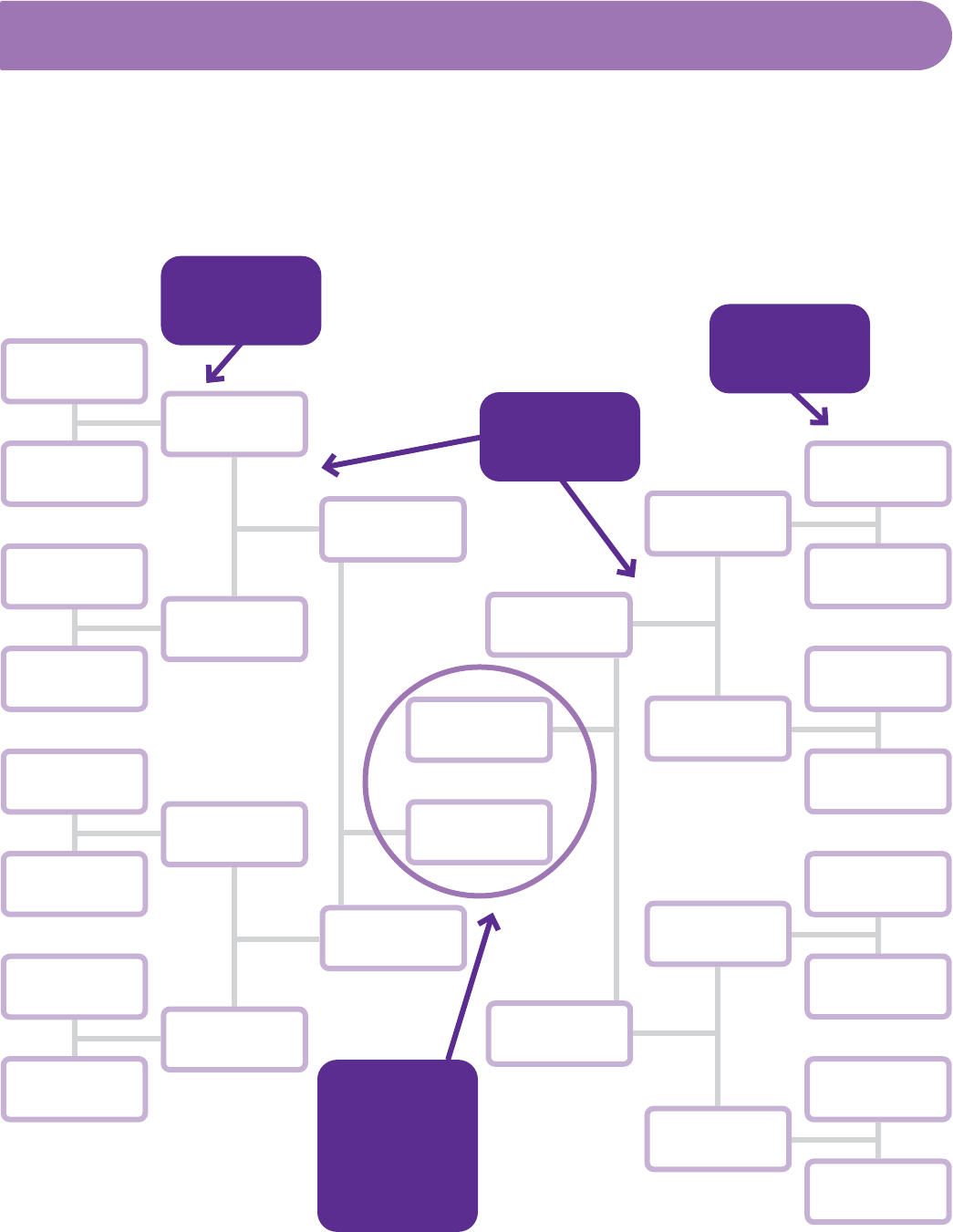
Cadette Workbook for Earning Your Silver Award | 28
Take Action Project Decision Bracket
What are your talents and skills?
What did you do for fun?
What bothers you?
What issues do you want to solve?
Who do you want to help?
Combine the nal pair to create
your Take Action project!
Step 3
For each bracket,
choose one.
Step 4
Continue until
you have a nal
pair, then combine
them to create your
project!
Step 1
Fill in these boxes.
Step 2
Fill in these boxes.
making
schedules
bullying on
social media
playing
volleyball
kids who
need friends
giving
presentations
no after-school
STEM club
creating
apps
my brother’s
teasing
cooking
cooking
cooking
texting
and driving
making
movies
abandoned
pets
playing
the guitar
too much
homework
hanging out
with friends
dangerous
intersection
creating
apps
creating
apps
creating
apps
dangerous
intersection
making
movies
kids who
need friends
playing
the guitar
no after-school
STEM club
texting
and driving
texting
and driving
texting
and driving
dangerous
intersection
In this example, your Take Action project might be to create an app that locks your phone before you drive, then sends a unique code to someone
who’s not in the car. You can’t use your phone until the person with the code unlocks it.

Cadette Workbook for Earning Your Silver Award | 29
Mind Mapping Diagram
Try it!
Write your community issue in the center circle. Ask yourself: What activates the issue? Write your answers in the circles closest to the center circle
(add more if you need to). Then, explore further. Ask: “Why does this happen?” Place these answers in the smaller outer circles, like in our example
on page 13. Add as many of these circles as you like. These are your root causes. Select one or two root causes and you have the foundation of a
strong Silver Award Take Action project!
Step 2:
Ask: “What activates
the issue?”
Then, explore further.
(Place answers in circles just
outside the community issue.)
Step 3:
To nd the root cause,
ask: “Why does this
happen?”
(Place answers in outer circles.)
Step 1:
Write your
community issue.
(Place the answer in the inner circle.)
Step 2
Step 2
Step 1
Step 2
Step 3
Step 3
Step 3 Step 3
Step 3

Cadette Workbook for Earning Your Silver Award | 30
Try it! If you’re still unsure about a project idea, list the pros and cons of the ideas you’re considering.
Make a copy of this page for each idea you want to explore.
Pros/Cons Diagram
ConsPros
Project Idea
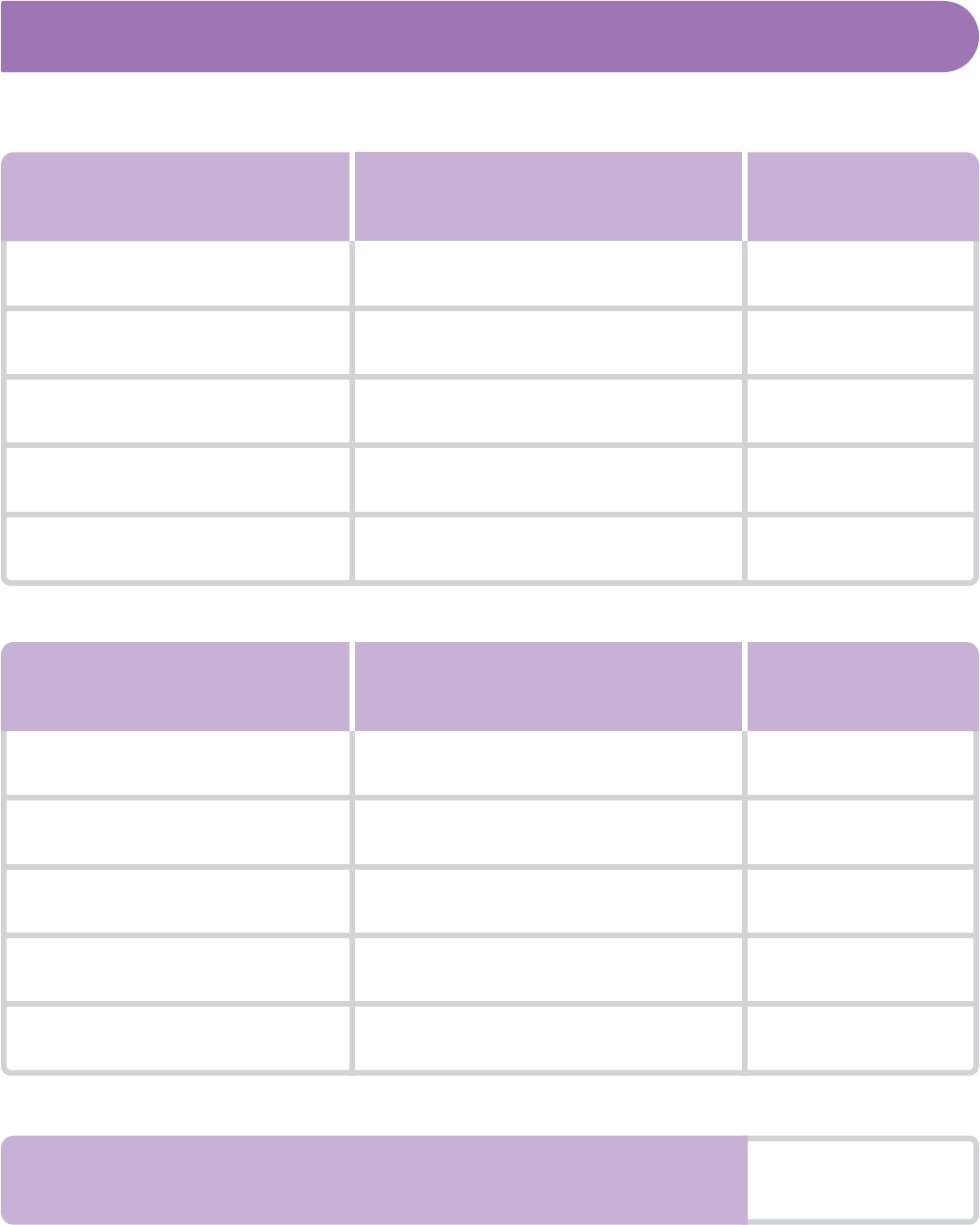
Cadette Workbook for Earning Your Silver Award | 31
(This is a sample. Other spreadsheet formats are also acceptable.)
Budget Worksheet
What is the item?
What is the item?
Balance
Expenses (-)
Funds/Donations (+)
[Money Earning/Troop Funds/Donations
(In-kind or monetary)]
(Purchased Supplies)
Who is it from?
Where is it from?
Total Value
Total Value
$0

Cadette Workbook for Earning Your Silver Award | 32
To-Do List
Task Who will do it?
How?
Supplies needed?
Date task needs
to be completed

Cadette Workbook for Earning Your Silver Award | 33
You must submit this log with your Girl Scout Silver Award Final Report. Only list time spent after you complete your Journey. Each Cadette
should spend approximately 50 hours working toward the Silver Award.
(This is a sample. Other spreadsheet formats are also acceptable.)
Time Log
Date Task Time Spent Running Total
Total Hours for Girl Scout Silver Award Project
